Overview
This article highlights the profound benefits of pediatric ABA therapy for children with autism, focusing on its essential role in enhancing communication, social skills, and independence, while also reducing challenging behaviors. It's crucial to understand that structured interventions, early access to therapy, and active family involvement play significant roles in maximizing these benefits. By embracing these elements, families can witness improved developmental outcomes for their children with autism.
As parents, you may find yourself navigating a complex journey. The insights shared here aim to resonate with your experiences and concerns. Imagine a world where your child communicates more effectively, builds meaningful relationships, and gains the independence they deserve. These are not just possibilities; they can be realities with the right support.
Consider the importance of early access to therapy. Research shows that the sooner children begin ABA therapy, the better their outcomes can be. This structured approach not only addresses challenging behaviors but also fosters essential skills that will benefit them throughout their lives. The journey may be challenging, but with the right resources and support, you and your child can thrive.
We encourage you to explore these options and connect with professionals who can guide you. Sharing your experiences and seeking support from others can make a significant difference. Together, we can create a nurturing environment that empowers our children to reach their fullest potential.
Introduction
In the realm of autism support, Applied Behavior Analysis (ABA) therapy emerges as a transformative approach that empowers children and their families. It is truly remarkable how ASD Media plays a pivotal role in this landscape by providing essential resources and insights that enhance the implementation of ABA therapy. Imagine a world where children improve their communication skills, foster independence, and reduce challenging behaviors—ABA techniques are designed to equip them with the tools they need to thrive in various aspects of life.
As research continues to unveil the effectiveness of these strategies, the importance of community support and parental involvement becomes increasingly evident. This article delves into the multifaceted benefits of ABA therapy, highlighting how tailored interventions can lead to significant improvements in the lives of children with autism. Together, we can create a brighter future for them and their families, filled with hope and opportunities.
About ASD Media: Empowering Parents with ABA Therapy Resources
At ASD Media, we are deeply committed to promoting the application of pediatric ABA therapy practices. Our goal is to provide valuable insights and strategies that address common challenges and enhance outcomes for families and professionals alike. We offer a comprehensive array of resources tailored specifically for parents and those in the field, fostering a nurturing and welcoming community where individuals can share experiences, learn from one another, and find essential support along their journeys.
By signing up for our newsletter, you will gain access to the latest updates and unlimited digital resources, empowering you to unlock the potential of children with autism and ADHD. We equip parents and professionals with effective strategies for managing challenging behaviors, accessing support services, and enhancing social skills development.
Recent statistics reveal that 57.2% of children in urban areas receive behavioral assistance, compared to only 46.4% in rural settings. This highlights the disparities in access to pediatric ABA therapy that many families face. Moreover, ongoing research continues to debunk misconceptions surrounding autism, such as the unfounded belief that vaccines cause the condition. This underscores the importance of evidence-based methods in pediatric ABA therapy practices. Our case studies, enriched with insights from research on the causes of autism and the role of genetics, illustrate the vital importance of community support in effectively applying pediatric ABA therapy. This collaboration not only fosters growth within the industry but also empowers parents and professionals, ensuring they have the tools and knowledge necessary to provide effective care for youth with autism. Together, we can make a meaningful difference in the lives of these children and their families.
Improved Communication Skills: Enhancing Interaction Through ABA Therapy
Pediatric ABA therapy offers a variety of methods, including Discrete Trial Training (DTT) and Natural Language Acquisition, designed to significantly enhance communication skills in children. These approaches aim to teach children how to express their needs and engage in meaningful conversations. By breaking down communication into manageable steps, children learn to use language effectively, which greatly improves their interactions with peers and adults, especially when they receive pediatric ABA therapy.
Research indicates that children who begin pediatric ABA therapy intervention before the age of four are more likely to achieve key developmental milestones in social skills and language use. This highlights the critical importance of early intervention, as timely access to pediatric ABA therapy can lead to substantial improvements in communication abilities. For instance, a case study on the impact of ABA methods on social skills found that children receiving structured interventions showed enhanced social interactions, closely linked to their communication skills, resulting in better peer relationships and increased community involvement.
However, statistics reveal that only 15% of insured children referred for ABA-based behavioral health treatment receive 80% or more of the recommended treatment hours. This limited access can hinder the communication development of young individuals, highlighting the urgent need for policy changes to expand insurance coverage for pediatric ABA therapy. Such improvements could facilitate access to these vital communication-enhancing techniques, ultimately benefiting children's overall development and quality of life.
Moreover, recent studies have shown that Discrete Trial Training is particularly effective in fostering communication skills, with many children demonstrating significant progress in their ability to articulate needs and engage in conversations. Natural Language Acquisition also plays a vital role, encouraging young learners to use language in real-life contexts, further boosting their communication abilities. Expert opinions reinforce the effectiveness of these methods, emphasizing the importance of early diagnosis and prompt intervention in optimizing developmental outcomes.

Enhanced Social Skills: Fostering Connections with ABA Techniques
ABA techniques can significantly enhance social abilities through structured interventions designed to help children learn how to initiate conversations, interpret social cues, and participate in group activities. Techniques such as modeling, role-playing, and social stories play a crucial role in this journey, allowing children to practice and apply their skills in real-life situations. By providing a systematic approach to addressing behavioral challenges, pediatric ABA therapy techniques lead to improved social interactions and a better quality of life for individuals with ASD. Role-playing, in particular, has proven to be exceptionally effective. Studies indicate that approximately 70% of individuals diagnosed with autism are currently receiving some form of treatment, highlighting the widespread recognition of these methods within the broader context of ABA therapy. A notable case study revealed that children engaged in role-playing interventions exhibited significant improvements in their cognitive abilities and communication skills, enabling them to express their needs more clearly and reducing feelings of frustration.
Recent research underscores the importance of social skills training, with experts emphasizing how modeling and role-playing can foster meaningful connections. The collaborative effort among therapists, families, and children is vital in maximizing the benefits of pediatric ABA therapy, ultimately leading to enhanced social skills and an improved quality of life for individuals with autism. Parents are encouraged to take an active role in their children's pediatric ABA therapy by exploring role-playing techniques and discussing their implementation with therapists. Your involvement can make a profound difference in your child's journey toward social success.
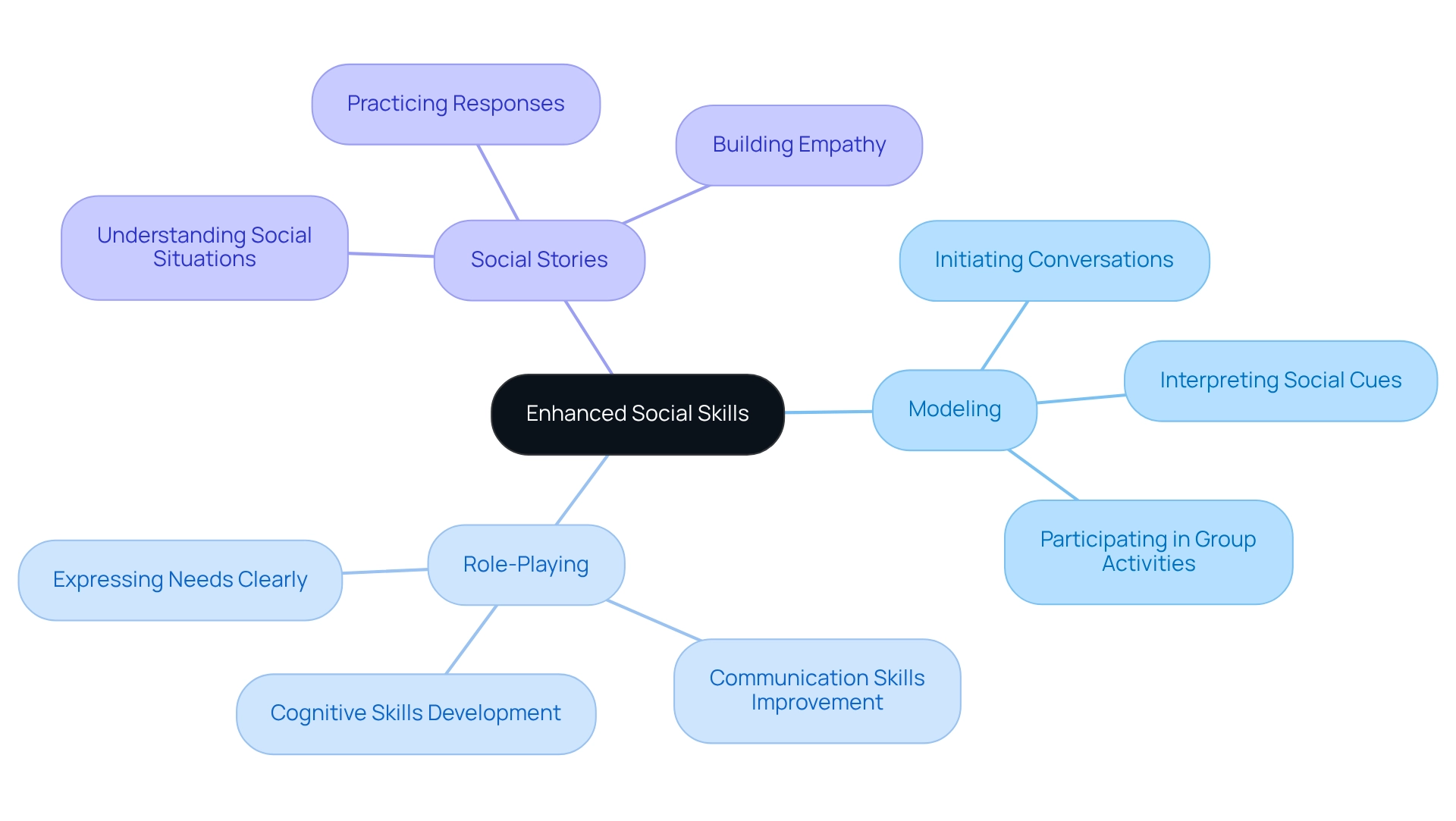
Increased Independence: Promoting Self-Sufficiency in Children
ABA intervention plays a vital role in nurturing independence among young individuals by equipping them with essential life skills, such as self-care routines, decision-making, and problem-solving. As Ralph Moller wisely notes, "By focusing on the specific needs of the individual with autism, rather than just the diagnostic label, therapy can be adapted to address the individual's specific goals and promote progress." Through methods like task analysis and positive reinforcement, children are guided to complete daily tasks independently, significantly enhancing their self-sufficiency. This emphasis on independence not only prepares them for future challenges but also fosters a sense of autonomy and confidence.
It's important to recognize that statistics reveal 75.6% of teenagers with autism spectrum disorder (ASD) score below age-expected standards for daily living abilities. This highlights an urgent need for effective interventions. By addressing these deficits through pediatric aba therapy, we can help young individuals thrive in various settings. Case studies demonstrate that teaching skills in natural environments allows children to generalize their learning, which further boosts their adaptability and confidence.
By prioritizing life skills training through pediatric aba therapy methods, practitioners can empower children to gain the autonomy they need for successful transitions into regular education and daily living. Together, we can support our children in reaching their fullest potential.
Reduced Challenging Behaviors: Creating a Positive Environment
Pediatric ABA therapy plays a crucial role in reducing challenging behaviors by systematically identifying triggers and implementing tailored strategies. Techniques such as positive reinforcement, redirection, and functional behavior assessments are essential in promoting desirable behaviors while minimizing negative ones. Research indicates that participants in ABA interventions experience significant improvements, with studies showing up to a 50% increase in social skills, communication, and emotional regulation. This underscores the effectiveness of the approach. This proactive approach not only improves the behavior of young ones but also fosters a more positive and supportive atmosphere at home and in social settings through pediatric ABA therapy. Imagine the relief of seeing your child thrive in their interactions!
Moreover, the adaptability of pediatric ABA therapy extends beyond adolescents, as illustrated by case studies that demonstrate its use in addressing challenging behaviors in adults with developmental disabilities or brain injuries. This broad therapeutic potential highlights the significance of pediatric ABA therapy interventions across various age groups and conditions, reinforcing its value in fostering positive behavioral changes.
As the Apricoott team observes, 'ABA practice can be a highly fulfilling profession, as practitioners have the chance to create a positive influence on the lives of youth and their families.' To implement positive reinforcement strategies at home, parents can start by identifying specific behaviors they want to encourage and consistently rewarding those behaviors with praise or small incentives.
Moreover, functional behavior assessments assist in comprehending the reasons behind challenging behaviors, enabling more effective interventions customized to each individual's needs. If you’ve faced challenges in understanding your child’s behavior, remember that you’re not alone. There are resources and support available to help you navigate this journey together.
Improved Focus and Attention: Enhancing Learning Capabilities
ABA therapy offers a nurturing approach to enhancing focus and attention in young individuals, utilizing structured routines and tailored interventions. For instance, visual schedules provide clear, step-by-step guidance, helping children understand expectations and transitions. This method has been shown to significantly improve learning outcomes, as children using visual schedules often demonstrate increased engagement during activities, leading to better academic performance and cognitive growth.
Reinforcement techniques, such as rewarding children for maintaining focus, play a vital role in enhancing concentration. Techniques like differential reinforcement—where rewards are given for desired behaviors while minimizing attention for undesired ones—are especially effective. By reducing distractions and fostering a supportive educational environment, ABA therapy creates a space where children can truly thrive. Case studies reveal remarkable advancements in concentration and attentiveness among children undergoing ABA therapy, with many developing essential skills for navigating classroom dynamics. For example, the case study titled 'ABA's Role in Fostering Educational Success' highlights how these methods enhance critical skills like communication and self-regulation, which are crucial for academic achievement.
Statistics indicate that children with autism who engage in ABA therapy experience significant improvements in their focus, with studies showing up to a 40% increase in attention span over just six months. This statistic underscores the effectiveness of structured, evidence-based approaches in ABA therapy. Experts emphasize the importance of personalized treatment strategies that cater to each child's unique needs, ensuring that interventions are both effective and relevant. As Ralph Moller aptly notes, "A personalized treatment plan takes into account the unique needs and preferences of the individual, allowing for tailored interventions that are most effective for their specific challenges." In summary, the organized, evidence-supported methods of ABA therapy not only enhance focus and attention but also foster essential cognitive and academic growth for children with autism.
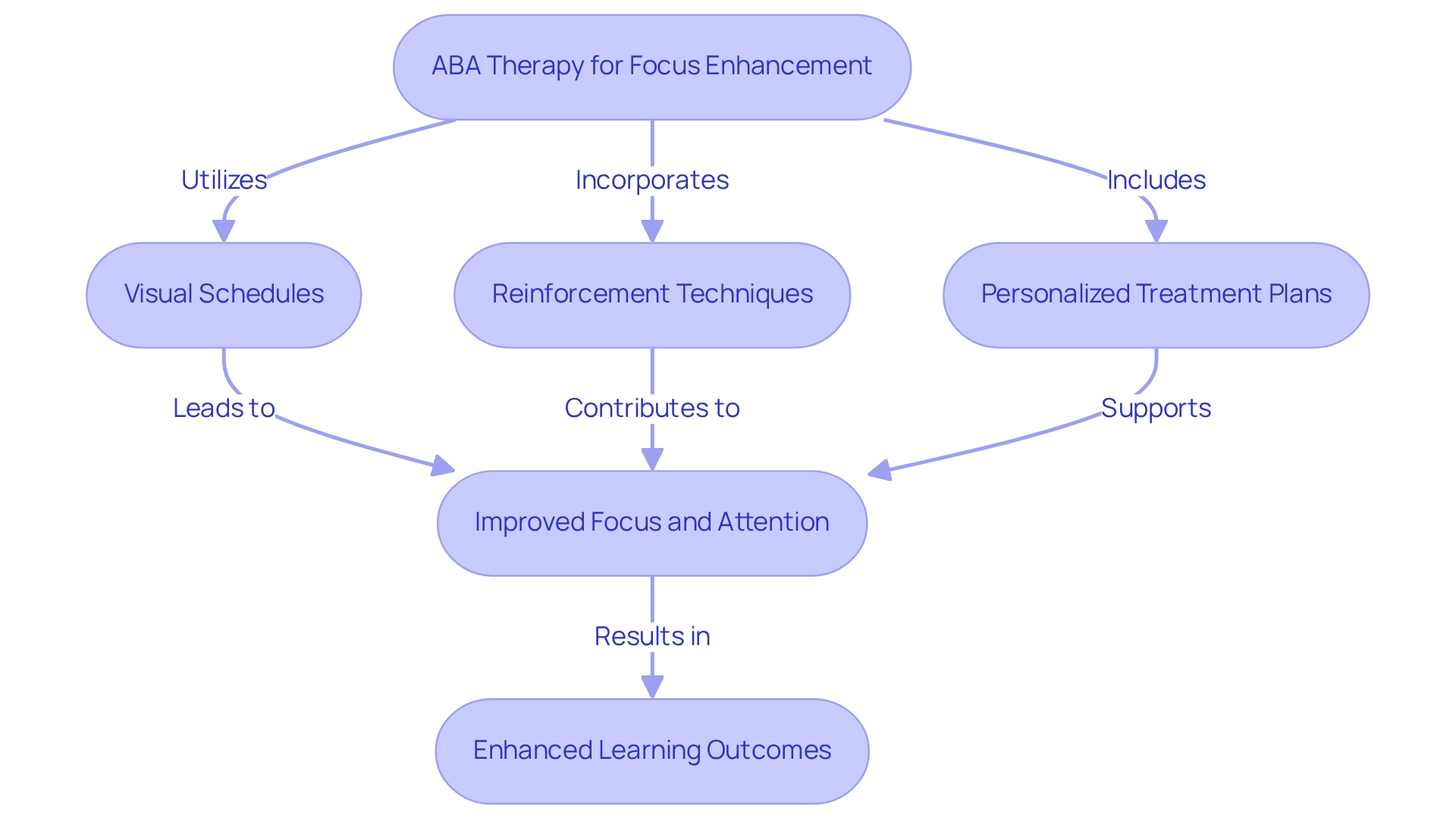
Generalization of Skills: Applying Learning Across Different Contexts
The broad application of abilities is crucial for helping young individuals utilize what they learn in sessions within practical scenarios. Pediatric ABA therapy employs various strategies, including diverse practice settings and role-playing, to encourage this transfer of skills. Research highlights that interventions are more effective when parents, teachers, or peers act as mediators, assisting young individuals in adapting their learned behaviors across different contexts. Notably, there is a significant reduction in intervention effects from proximal measurement to functional outcomes, emphasizing the need for effective ability generalization. This approach not only enhances versatility but also equips young people to navigate various social and academic challenges.
For instance, a case study titled 'How Pediatric ABA Therapy Can Help Kids Learn Through Structured Play' illustrated that incorporating structured play within pediatric ABA therapy significantly improved youngsters' cognitive and social abilities. This showcases the effectiveness of diverse practice environments in promoting ability transfer. Furthermore, Thiemann‐Bourque et al. found that all nine studies they reviewed supported generalization by involving parents, teachers, or peers as mediators of the intervention.
Ultimately, fostering ability generalization through pediatric ABA therapy is essential for individuals with autism, as it empowers them to apply their skills in daily interactions and environments. To support this process, parents can create opportunities for their children to practice learned skills in various settings, reinforcing their ability to generalize these skills effectively. By doing so, parents not only help their children thrive but also cultivate a nurturing environment that encourages growth and development.
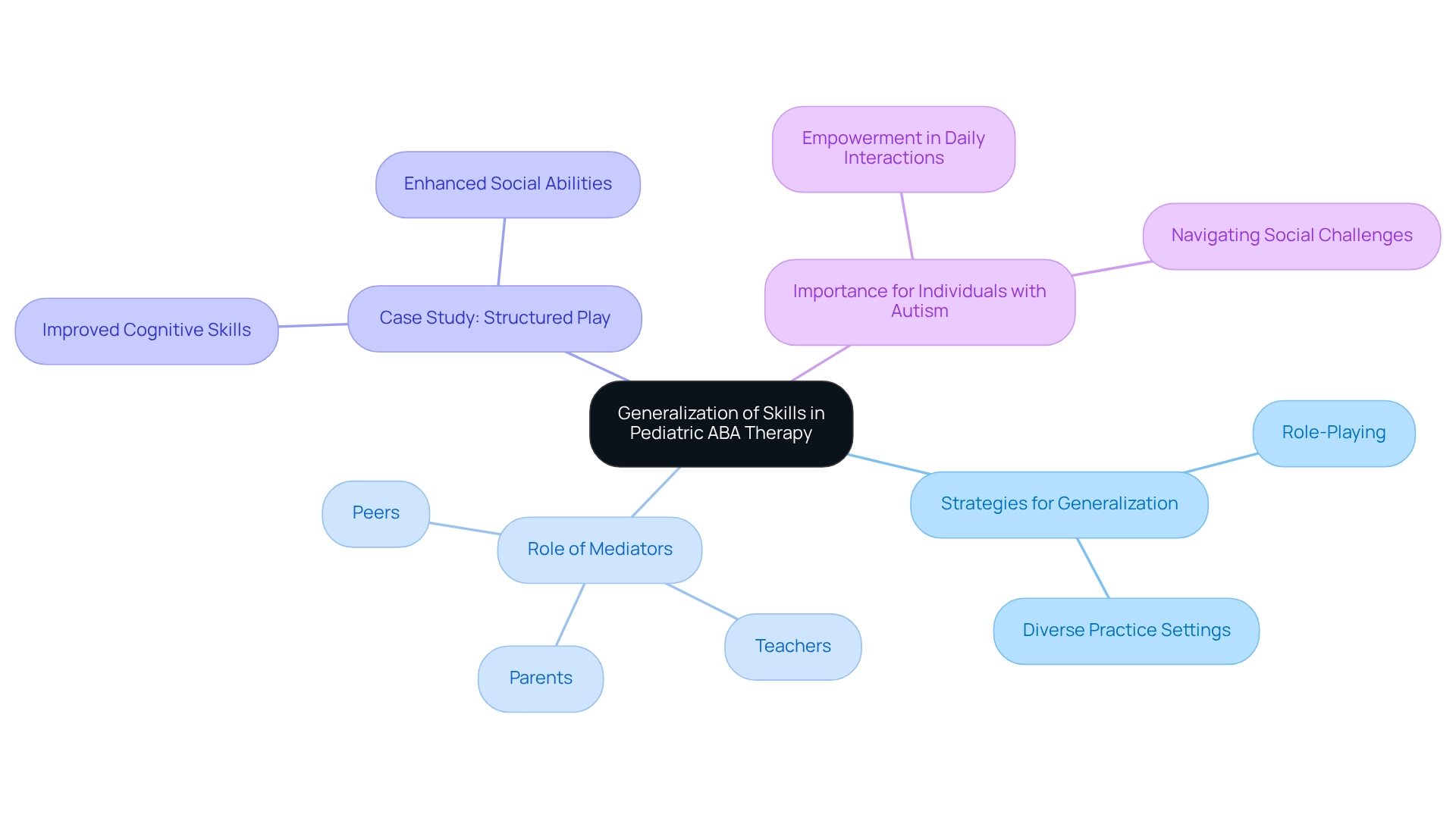
Positive Reinforcement: Motivating Behavior Change Effectively
Positive reinforcement stands as a cornerstone of pediatric ABA therapy, aimed at encouraging desired behaviors through rewarding experiences. This nurturing approach can take various forms, such as verbal praise, tokens, or access to preferred activities. By consistently applying these techniques, therapists help young individuals associate positive outcomes with specific behaviors, nurturing their motivation to engage in and repeat those behaviors.
Current statistics reveal that implementing positive reinforcement strategies significantly enhances behavior change in young individuals. For instance, studies have shown that reward systems, like the PBIS system, can lead to a notable reduction in schoolwide disciplinary actions and suspension rates. This underscores their effectiveness in promoting positive behavior and fostering a supportive environment for our children.
The impact of rewards on behavior change is indeed profound. When young individuals receive prompt and meaningful reinforcement, they are more likely to internalize the desired behaviors. However, it is essential to implement these systems with care. Feedback from parents has highlighted concerns regarding the emotional toll of reward systems, particularly the anxiety and pressure they can create. This emphasizes the necessity for a balanced approach that nurtures youth well-being while encouraging positive behavior. A case study titled 'Parental Concerns with Reward Systems' illustrates these issues, as parents express genuine worries about the emotional impact of reward systems on their children.
Real-world examples further illustrate the effectiveness of positive reinforcement in pediatric ABA therapy. For example, children who receive consistent praise for social interactions often demonstrate significant advancements in their social skills over time. Additionally, expert insights suggest that intrinsic motivation—engaging in activities for their inherent satisfaction—plays a vital role in sustaining behavior change. As Zihan Chen notes, "Intrinsic motivation refers to the drive to engage in a learning activity for its inherent satisfaction and personal interest." Thus, while reward systems can be beneficial, they must be thoughtfully tailored to each child's unique needs to prevent potential adverse effects.
In summary, positive reinforcement methods in pediatric ABA therapy not only encourage behavior change but also require thoughtful consideration to ensure they foster a supportive atmosphere for young individuals. While evidence supports the effectiveness of reward systems, it is crucial to implement them mindfully in pediatric ABA therapy to enhance the therapeutic experience and outcomes for children with autism. We encourage parents to share their experiences and seek support as we navigate this journey together.
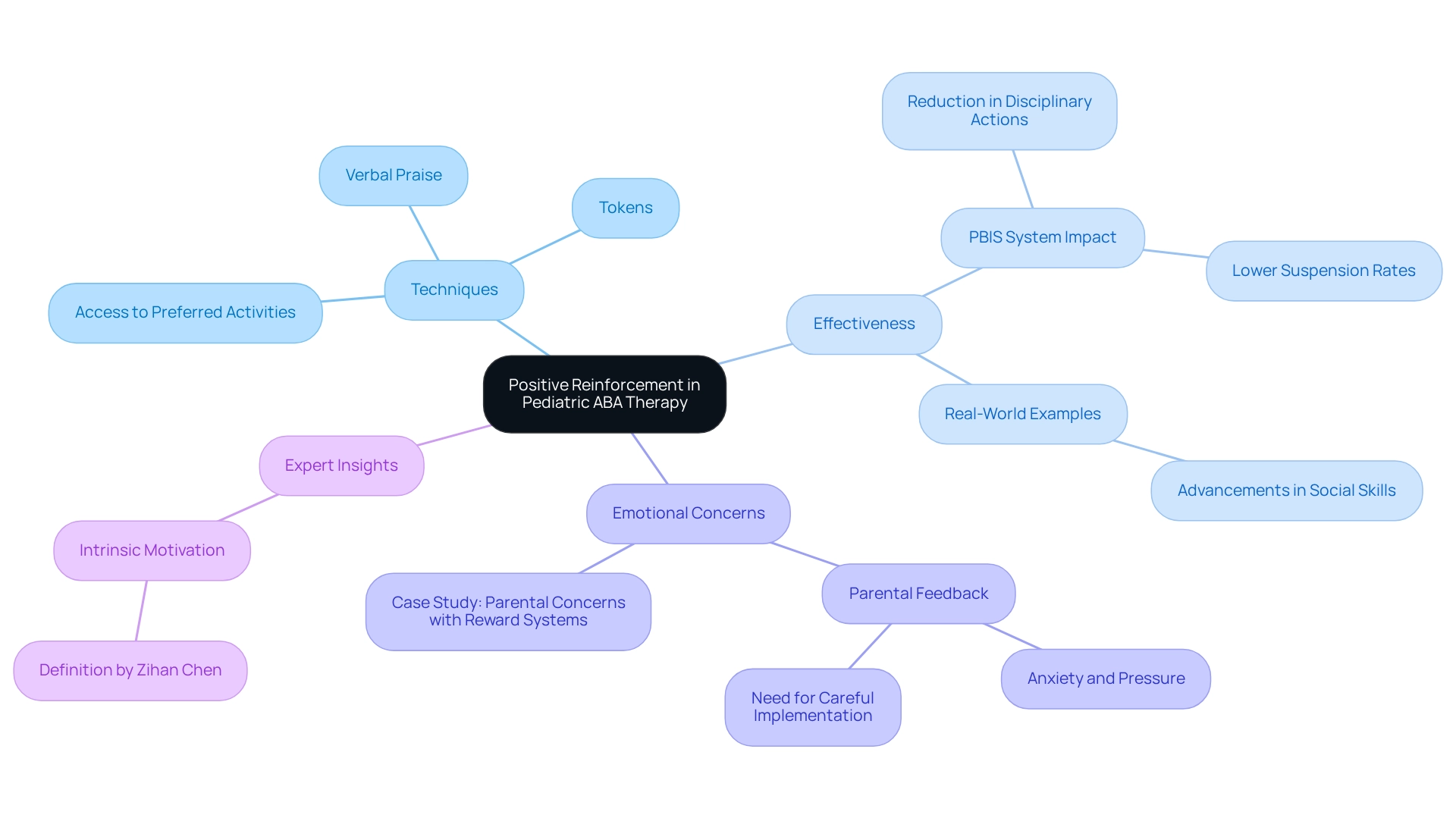
Data-Driven Progress Monitoring: Ensuring Effective Interventions
Data-driven progress monitoring plays a vital role in ABA practice, allowing therapists to thoughtfully evaluate the effectiveness of interventions and make informed adjustments. By systematically gathering data on a young person's behaviors and responses, therapists can assess their progress and identify areas for enhancement. This evidence-driven approach not only tailors interventions to meet each individual's unique needs but also encourages active parental involvement in the data collection process, fostering trust and commitment to treatment. As ASD Media highlights, "Through regular analysis of collected data, behavior analysts can fine-tune their approach, ensuring interventions are both personalized and effective."
Recent advancements in technology have made data collection more streamlined, providing real-time insights that facilitate timely modifications to treatment plans. For example, the case study titled "Real-Time Insights from Technology in ABA Therapy" illustrates how technology enhances data quality and accountability, improving therapeutic efficiency and enabling adjustments based on measurable outcomes. Experts stress that embracing data-driven decision-making enriches the lives of those seeking support, resulting in more empowered interventions.
Ultimately, this collaborative approach ensures that children receive the most appropriate and impactful care throughout their developmental journey. Additionally, establishing achievable objectives in ABA treatment is crucial for attaining successful results, highlighting the importance of a systematic and data-driven method.
Family Involvement: Strengthening Support Systems for Success
Family involvement in pediatric ABA therapy is vital for reinforcing skills and ensuring consistency across different environments. Parents and caregivers actively apply techniques learned during counseling sessions at home. This not only enhances the young one's support system but also deepens their understanding of their child's needs and progress.
Research shows that when families are engaged, therapy outcomes improve significantly. For example, a study revealed that 23% of children referred for services did not receive subsequent support, highlighting the critical role of ongoing family involvement in ensuring that children receive the necessary care and resources.
Practical instances demonstrate that collaborative efforts between parents and therapists can lead to improved adaptive behaviors and retention of skills. Experts emphasize that parental involvement is crucial for achieving significant progress, as it enables the enhancement of abilities in daily situations.
According to Karen J. Coleman, PhD, MS, "To effectively translate research evidence on ASD interventions into wide-scale practice, an implementation framework is needed for states with autism mandates to address system, community, and family barriers and promote meaningful patient progress."
By actively engaging in their child's treatment, parents can create a supportive environment that fosters growth and development, ultimately leading to better outcomes in pediatric ABA therapy. Parents can reinforce skills learned in therapy at home by consistently practicing these strategies, establishing routines that incorporate learned behaviors, and maintaining open communication with therapists to ensure alignment in approaches.
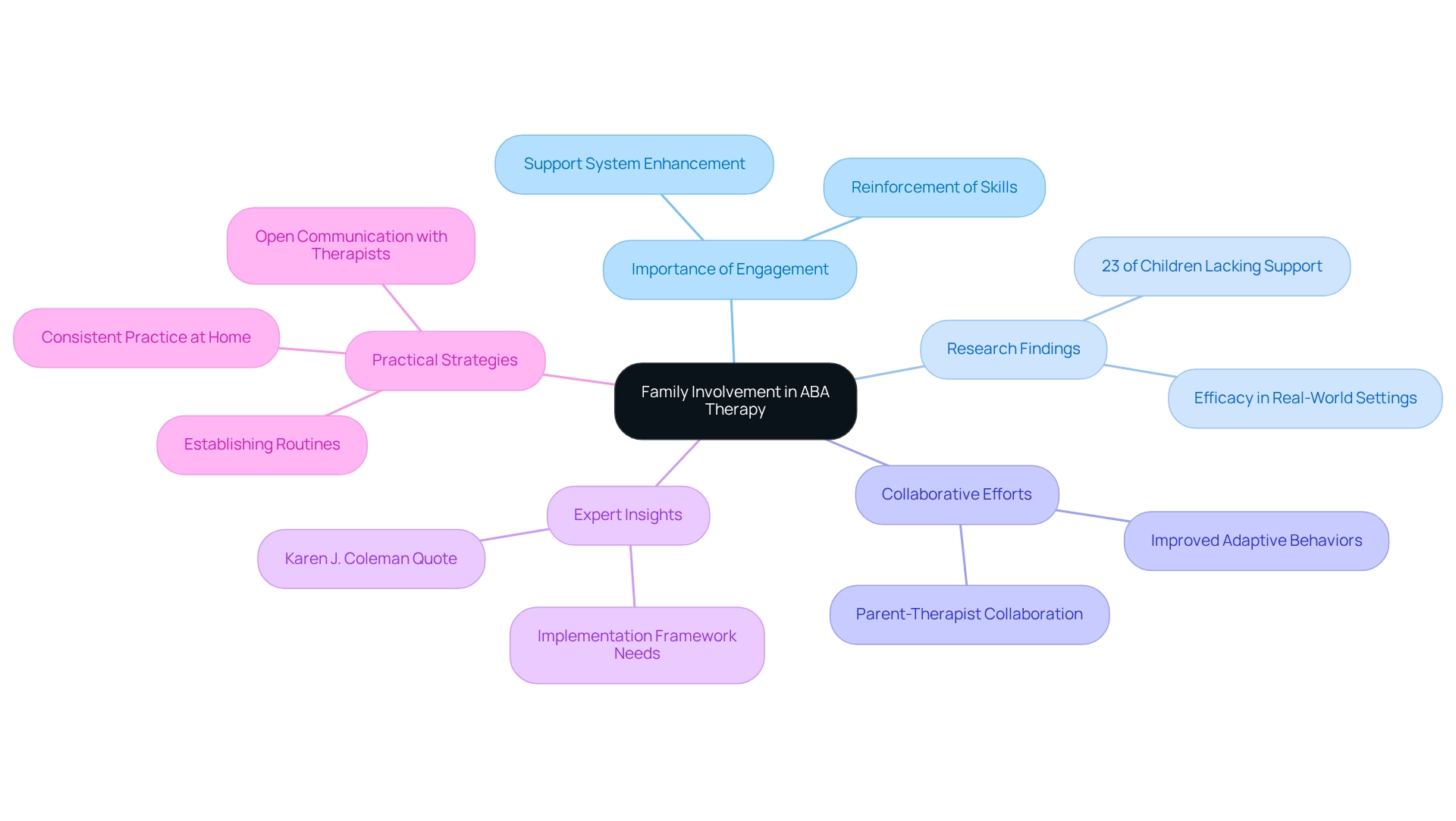
Conclusion
ABA therapy serves as a profound resource for children with autism and their families, dedicated to enhancing communication, social skills, independence, and positive behavior. Techniques such as Discrete Trial Training and Natural Language Acquisition play a pivotal role in improving communication, highlighting the importance of early intervention in reaching developmental milestones.
This therapy also nurtures social skills and independence through structured approaches like role-playing and task analysis. These methods equip children with vital life skills and bolster their confidence, preparing them for future challenges.
Family involvement stands as a cornerstone of successful ABA therapy. When parents and caregivers actively participate, they reinforce learned behaviors and establish a consistent support system, which ultimately leads to better therapeutic outcomes.
As ongoing research continues to validate the effectiveness of ABA therapy, the necessity for community support and accessible resources, such as those offered by ASD Media, becomes increasingly clear. By collaborating through informed interventions, we can pave the way for a brighter future filled with opportunities for children with autism. The journey toward meaningful change is not only possible but essential for cultivating an inclusive society.
Frequently Asked Questions
What is the main focus of ASD Media?
ASD Media is committed to promoting pediatric ABA therapy practices and providing insights and strategies to address challenges and enhance outcomes for families and professionals in the field.
What resources does ASD Media offer to families and professionals?
ASD Media offers a comprehensive array of resources tailored for parents and professionals, including access to the latest updates, digital resources, and effective strategies for managing challenging behaviors and enhancing social skills development.
How does ASD Media support the community?
ASD Media fosters a nurturing community where individuals can share experiences, learn from one another, and find essential support along their journeys related to autism and ADHD.
What are the statistics regarding access to behavioral assistance for children?
Recent statistics show that 57.2% of children in urban areas receive behavioral assistance, compared to only 46.4% in rural settings, highlighting disparities in access to pediatric ABA therapy.
What misconceptions about autism does ASD Media address?
ASD Media addresses misconceptions such as the unfounded belief that vaccines cause autism and emphasizes the importance of evidence-based methods in pediatric ABA therapy practices.
What methods are used in pediatric ABA therapy to enhance communication skills?
Pediatric ABA therapy employs methods like Discrete Trial Training (DTT) and Natural Language Acquisition to significantly improve communication skills in children by teaching them to express their needs and engage in meaningful conversations.
Why is early intervention important in pediatric ABA therapy?
Research indicates that children who begin pediatric ABA therapy before age four are more likely to achieve key developmental milestones in social skills and language use, making timely access critical for substantial improvements.
What challenges do families face in accessing ABA therapy?
Statistics reveal that only 15% of insured children referred for ABA-based treatment receive 80% or more of the recommended treatment hours, indicating limited access that can hinder communication development.
What role do techniques like modeling and role-playing play in ABA therapy?
Techniques such as modeling, role-playing, and social stories are crucial in enhancing social abilities by helping children learn to initiate conversations, interpret social cues, and participate in group activities.
How can parents be involved in their child's ABA therapy?
Parents are encouraged to take an active role by exploring role-playing techniques and discussing their implementation with therapists, which can significantly impact their child's journey toward social success.




